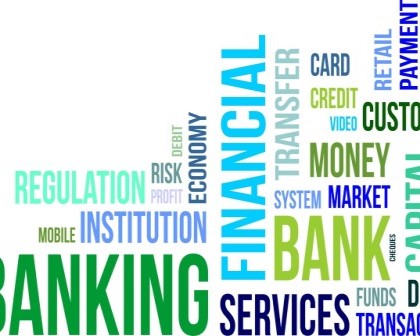Although it takes time and resources, creating and implementing a digital marketing strategy does not have to be expensive for small banks.

Leveraging Digital, Direct Mail, and Social Media to Drive Business Customer Acquisition
Many community and regional banks are discovering that most of their business customers reside in a digital world. More than 80 percent of consumers use the internet to search for businesses and check reviews. Almost half use social media and blogs looking for solutions and products, relying heavily on their online communities for ideas. Businesses that fail to connect with their target market digitally risk sliding into irrelevance. To many consumers, if your business can't be found online, you don't exist.
From a small bank's perspective, the available tools and technology offer the opportunity to vie for consumers' attention at the same level as larger banks. Digital marketing has leveled the playing field, providing small businesses the capability to expand their reach and the added advantage of appealing directly to their target market. All businesses, large and small, work from the same general blueprint with the same tools to create their digital marketing strategy.
Creating the Right First Impression
Most banks have a website. The question is whether it creates an immediate and lasting impression or leaves much to be desired. Your website is the gateway to your bank. It must be attractive and dynamic enough to attract visitors and make them want to stay. It also becomes the digital hub of your strategy, directing visitors to and from your social media and email campaigns.
The most important initial investment you can make in your digital marketing strategy is in web design, search engine optimization (SEO), and data analytics to measure visitor engagement.
Encouraging Digital Interaction Through Direct Mail
Contrary to popular belief, direct mail is far from dead. Email may be cheaper, but it is more likely to be ignored. Businesspeople especially are suffering from email fatigue. According to the Data & Marketing Association, nearly 90% of direct mail is opened and read compared to just 30% of email. Remarkably, 75% of consumers say they prefer physical mail to email, including younger audiences.
While direct mail should never be used as a standalone marketing strategy, it combines exceptionally well with a digital strategy to improve response rates. You can use QR codes in your direct mail pieces to direct consumers to online promotional offers, your social media sites, and your website to pursue additional information. They then become trackable through your digital apparatus, where they are more likely to engage with targeted emails.
Active Social Media Sites
In the span of a decade, social media has grown from a way to get connected to an ever-expanding socio-ecosystem on which mass communities rely for making fundamental decisions for their everyday lives. Banks can take advantage of social media sites, such as Facebook, Instagram, Twitter, and LinkedIn, to expand their digital influence and build social capital that can be converted to new customers. At a minimum, your presence on social media serves as proof that you do exist and that you have something of value to offer.
The key is to treat social media as a means to increase brand visibility in your target market rather than as an "end" to generate new sales. Through active participation, your social media activities can drive more visitors to your website, where they can engage more directly with your business.
Take the First Step
Creating and implementing a digital marketing strategy doesn't have to be expensive, but it can take time and resources you may not have in large quantities. Fortunately, all the tools, technology, and expertise are accessible. The best approach for a small bank with limited resources is designing the strategy, implementing the components incrementally, and watching your return on investment grow over time.
Recent articles:

Using Financial Software to Streamline Small Business Bookkeeping - Automating your bookkeeping saves time, reduces errors, and gives you real-time insights—so you can focus on growth, not data entry.

Using Data Analytics to Drive Small Business Decisions - Data analytics empowers small businesses to make smarter decisions, cut costs, improve marketing, and stay competitive in today’s fast-paced market.

The Rise of Hybrid Work Models for Small Businesses - Hybrid work helps small businesses attract talent, save costs, and stay competitive, making flexibility a key driver of growth in 2025 and beyond.

Financial Planning for Seasonal Businesses - Seasonal businesses can thrive year-round by mastering cash flow, budgeting, and tax planning, turning challenges into lasting growth and stability.

Adapting to Changing Consumer Behaviors in 2025: Essential Steps for Small Businesses - In 2025, small businesses thrive by adapting to changing consumer behaviors—personalization, sustainability, omnichannel strategies, and value-focused offerings drive loyalty and growth.

Crafting a Realistic Cash Flow Forecast for 2025: A Guide for Small Businesses - A solid cash flow forecast helps small businesses anticipate challenges, seize growth opportunities, and thrive in 2025’ s uncertain economy.
Previous Articles:
- Understanding and Optimizing Your Business Credit Score
- The ROI of Automation: Affordable Tech Solutions for Small Business Growth
- High-Impact, Low-Cost Marketing Ideas for Small Businesses
- The Small Business Owner’s Guide to Managing Stress and Avoiding Burnout
- With Credit Tightening, How Small Businesses Can Build a Strong Financial Profile
- Post-COVID Trends That Small Businesses Can’t Afford to Ignore
- Standing Out in a Saturated Market: Tips for Small Business Differentiation
- Tightening the Belt: 10 Cost-Cutting Strategies for Small Businesses Facing Rising Expenses
- Five Steps Small Businesses Can Take to Increase Web Traffic
- Retention 101: Keeping Your Best Employees in a Competitive Market
- Creative Ways to Overcome Labor Shortages in Your Industry
- Preparing Your Business for the Next Recession: Actionable Tips
- 2025 Tax Updates for Small Businesses: What You Need to Know
- Email Marketing Mistakes Businesses Must Avoid
- Why Community Engagement is Crucial for Small Businesses
- Adapting to E-commerce: A Guide for Brick-and-Mortar Stores
- Harnessing the Power of Customer Reviews to Boost Your Business
- Small Business Owners Need an Integrated Approach to Post-Pandemic Financial Planning
- How to Build a Strong Brand Identity on a Budget
- The Future of Remote Work: Tips for Small Businesses to Thrive
- Navigating the Gig Economy: Opportunities and Challenges for Small Businesses
- Sustainable Business Practices: How Small Businesses Can Make a Big Impact
- 10 Essential Free Tools for Small Businesses
- 7 Ways Small Businesses Can Benefit from AI and Automation
- How to Leverage Social Media for Your Small Business in 2024
- The AI Advantage: How Small Businesses Can Thrive in the Age of Intelligence
- Shielding Your Business: Essential Insurance for Risk Management
- How Outsourcing Can Help Your Small Business Grow
- Securing Your Data: A Cloud Security Checklist for Small Businesses
- Mastering Cash Flow: How Banks Empower Small Businesses with Cash Management Tools
- Optimizing Productivity for a Remote Workforce
- Digital Strategies: The Engine of a Virtual Distribution Strategy
- Attracting and Engaging Gen Z: The Future of Your Workforce
- Managing Cash Flow for Business Prosperity
- How to Position Your Bank as a Trusted Advisor for Small Businesses—And Why It Matters
- Business Owners Need a Complete Risk Management Plan
- Preparing Your Business to Borrow
- Is Your Business Prepared for Generation Z?
- Small Business Trends You Don’t Want to Miss in 2024
- Ideas on How to Improve the Customer Experience
- Do You Use Website Analytics to Learn About Your Customers’ Interests?
- 5 Strategies to Incorporate into Your Business for 2024
- The Benefits of Mobile Banking and Remote Deposit Capture
- Should You Have a Blog on Your Website?
- Best Practices for Protecting My Business Online
- Using ACH to Improve Cash Flow
- 10 Ideas to Help You Recruit New Talent
- How AI Could Improve Your Business
- Using a Small Business Loan to Expand Your Services
- Local, State, and Federal Resources for Your Business
- Security Essentials for Keeping Business Data Safe
- Leveraging Your Bank’s Cash Management Services to Improve Your Business
- When is the Best Time to Obtain a Business Loan?
- How Much Insurance Do I Need for My Business?
- Incorporating the Latest Merchant Services Technology for Your Business
- A Checklist for Getting Your Small Business Tax Compliant
- How Third-Party Data Can Help Target Marketing
- Is Your Small Business Taking on too Much Debt? Steps to Take to Pay it Down More Quickly
- Leveraging Digital, Direct Mail, and Social Media to Drive Business Customer Acquisition
- Businesses Should Plan Ahead for Year-End Tax Strategies
- Cash Flow Management Tips for Small Businesses
- Recruiting Top-Tier Talent in a Tight Job Market
- Sales or Marketing – Banks Need Both to Grow Revenues
- The Biggest Security Threat to Your Business
- How to Prevent Employee Fraud in Your Business
- There's Still Time to Claim the Employee Retention Credit. What is it, and How to Qualify
- Preparing Your Business to Borrow
- Insurance Essentials for Managing the Many Small Business Risks
- Employers are finding that remote work can be an effective way to increase productivity and lower cost
- Don't Let Your Business be the Next Ransomware Victim
- Taking Advantage of Bank Cash Management Technology
- How to Take Your Digital Marketing to the Next Level
- How Annual Assessments Can Prevent Fraud in Your Business
- How to Position Your Bank as a Trusted Advisor for Small Businesses - And Why it Matters
- Getting to Yes with a Solid Loan Proposal
